

Wisdom Publications
199 Elm Street
Somerville, MA 02144 USA
www.wisdompubs.org
2012 Zen Trust
All rights reserved.
First Published by The Zen Trust, 1988, as A Treatise on the Ceasing of Notions.
Published in association with the Buddhist Society, London.
No part of this book may be reproduced in any form or by any means, electronic or mechanical, including photography, recording, or by any information storage and retrieval system or technologies now known or later developed, without permission in writing from the publisher.
Library of Congress Cataloging-in-Publication Data
Bodhidharma, 6th cent.
[Jue guan lun. English]
The Ceasing of notions : an early Zen text from the Dunhuang Caves / with selected comments by Soko Morinaga Roshi and an introduction by Martin Collcutt ; translated into German by Ursula Jarand, into English by Venerable Myokyo-ni and Michelle Bromley.
pages cm
Includes bibliographical references.
ISBN 1-61429-041-5 (pbk. : alk. paper)
1. Zen BuddhismDoctrinesEarly works to 1800. 2. Bodhidharma, 6th cent. Jue guan lun. I. Morinaga, Soko, 19251995, writer of added commentary. II. Collcutt, Martin, 1939 writer of added commentary. III. Jarand, Ursula, translator. IV. Myokyo-ni, translator. V. Morinaga, Soko, 19251995. Novice to master. Selections. 2013. VI. Title.
BQ9299.B624C4813 2013
294.385dc23
2012020570
ISBN 9781614290414 eBook ISBN 9781614290452
16 15 14 13 12 5 4 3 2 1
Cover design by Phil Pascuzzo. Interior design by Gopa & Ted2, Inc. Set in ITC Galliard.
Wisdom Publications books are printed on acid-free paper and meet the guidelines for permanence and durability of the Production Guidelines for Book Longevity of the Council on Library Resources.
Printed in the United States of America.
 This book was produced with environmental mindfulness. We have elected to print this title on 30% PCW recycled paper. As a result, we have saved the following resources: 14 trees, 6 million BTUs of energy, 1,183 lbs. of greenhouse gases, 6,416 gallons of water, and 430 lbs. of solid waste. For more information, please visit our website, www.wisdompubs.org. This paper is also FSC certified. For more information, please visit www.fscus.org.
This book was produced with environmental mindfulness. We have elected to print this title on 30% PCW recycled paper. As a result, we have saved the following resources: 14 trees, 6 million BTUs of energy, 1,183 lbs. of greenhouse gases, 6,416 gallons of water, and 430 lbs. of solid waste. For more information, please visit our website, www.wisdompubs.org. This paper is also FSC certified. For more information, please visit www.fscus.org.
Table of Contents

THE ORIGINAL TEXT AND THE TRANSLATION
T HE C EASING OF N OTIONS is the title given to the translation of one of the Chinese texts from Dunhuang, which are called the Jue-guan lun in Chinese and Zekkanron in Japanese. The vast caves near Dunhuang, an oasis on the ancient Silk Road in the Gansu province of western China, also known as the Mogao Caves and the Caves of the Thousand Buddhas, comprised a network of 492 ancient temples. From the fourth until the fourteenth century, Buddhist monks at Dunhuangwho used the remote caves as places for prayer and meditation in their search for enlightenmentcollected scriptures, sacred paintings, and statues from western Asia and Tibet. Pilgrims passing through the area painted murals covering some four hundred and fifty thousand square feet inside the caves. Construction of the Buddhist cave shrines began around 366 CE as places to store scriptures and works of art. The caves thus came to serve as repositories for thousands of sacred texts and to contain some of the finest examples of early Buddhist art spanning a period of a thousand years.
Sometime after the eleventh century, some of the caves were walled off and used as storehouses for used and damaged manuscripts and religious objects. They remained virtually unknown until the early twentieth century. Then, in the early 1900s, a Chinese Daoist named Wang Yuanlu, who was acting as the guardian of some of these cave temples, discovered a walled-up area beside a corridor leading to a main cave. Behind the wall was a small cave stuffed with an enormous hoard of manuscripts and paintings on hemp, silk, or paper dating from 406 to 1002 CE. These included ancient Buddhist texts in Chinese and other Asian languages. Among them were several manuscript copies of the text offered here as The Ceasing of Notions.
Around 1907, Wang Yuanlu sold many of the ancient scrolls to Western travelers exploring the Silk Road, including Sir Aurel Stein and Paul Pelliot, who eagerly acquired these rare Buddhist texts and carried them back to Europe. The Japanese Buddhist scholars D. T. Suzuki and Kuno Horyu, among others, seem to have rediscovered copies of the text in Pelliots collection in the early 1930s.
Discussing, as it does, the path to enlightenment, this text has long had an important place in Chinese and Japanese Zen thought and practice. This text has also been partially translated into English by John R. McRae in his illuminating essay The Ox-head School of Chinese Chan Buddhism: From Early Chan to the Golden Age. Ursula practiced Zen in Kyoto under the guidance of Soko Morinaga Roshi for many years. Her German translation, like this one, incorporates a Japanese commentary on the text by Soko Morinaga Roshi.
Venerable Myokyo-ni, who founded the Zen Centre in London on her return from training at Daitokuji in Kyoto, where she met Soko Morinaga Roshi, felt a strong affinity with this text. She recognized its importance and the value of Morinaga Roshis commentary as a training aid for Zen students. Therefore this present translation, made by the Venerable Myokyo-ni and Michelle Bromley, takes into account earlier German, English, and Japanese translations but places more emphasis on accessibility and helpfulness to readers who are practicing Zen, or interested in Zen, than on severe literalness or heavy scholarly apparatus. To this end, the title of the Chinese text translated rather abstractly by one scholar as A Dialogue on the Contemplation Extinguished and by McRae as A Treatise on the Transcendence of Cognition is rendered simply as The Ceasing of Notions, which
The Jue-guan lun ( The Ceasing of Notions) in its earliest form was a series of brief questions about the practice of the Buddhist Way and the attainment of understanding by a novice, known in Japanese as Emmon and in Chinese as Yuanmen, and the responses by his teacher, the monk known in Japanese as Nyuri and in Chinese as Ruli. Emmons questions express or reveal his clinging to notions of delusions about the Way and the attainment of true understanding. Nyuris answers, often enigmatic, are intended to encourage Emmon to shed his notions and recognize the truth of his buddhahood, which has always been his, if he would only see it. Because the questions and answers are often terse and their full implications difficult for a reader to grasp, it is very helpful to have the straightforward, insightful commentary provided here by Soko Morinaga Roshi.
THE ZEN LITERATURE OF QUESTION, ANSWER, AND COMMENTARY
As readers respond to the challenges of Emmons questions, ponder the implications of Nyuris responses, and reflect on the wider understanding provided by Morinaga Roshis comments, they will quickly realize that this text, in its original form, and with the added commentary by Morinaga Roshi, is an early example of a form of question and answer literature, and of a literature of commentary, that has played such an important role in the transmission of Buddhist teaching, and especially of Zen Buddhism. I am thinking here of the various collections of Zen cases known as
Next page
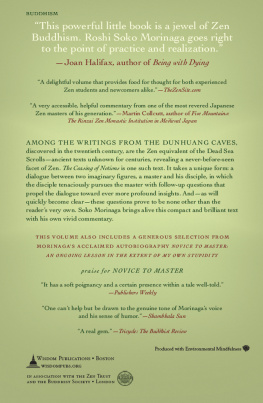
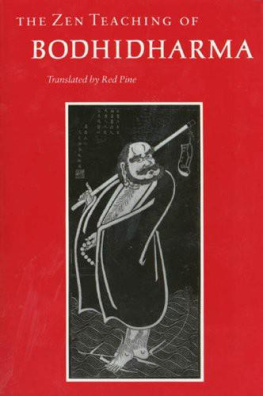



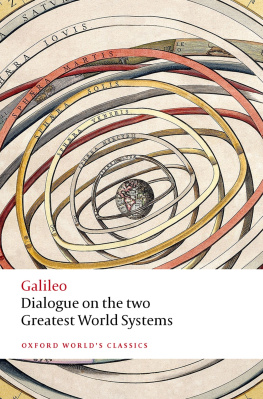
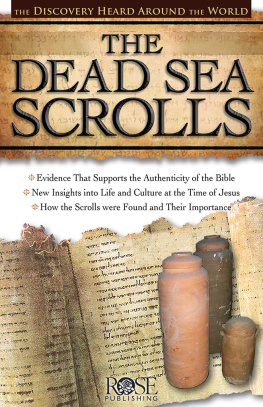
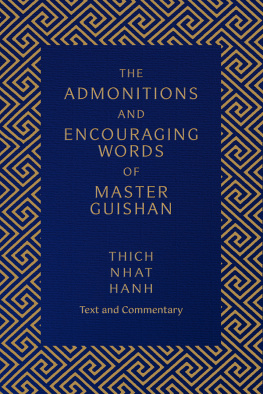
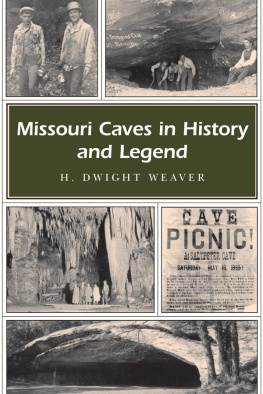
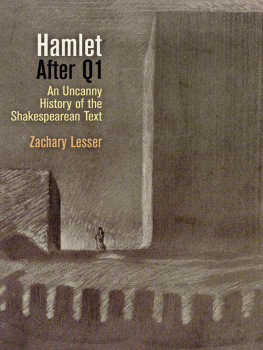

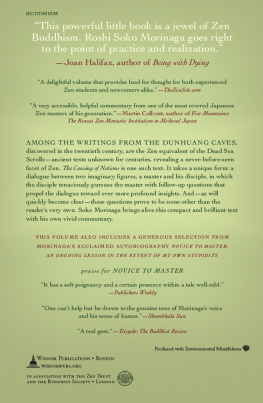




 This book was produced with environmental mindfulness. We have elected to print this title on 30% PCW recycled paper. As a result, we have saved the following resources: 14 trees, 6 million BTUs of energy, 1,183 lbs. of greenhouse gases, 6,416 gallons of water, and 430 lbs. of solid waste. For more information, please visit our website, www.wisdompubs.org. This paper is also FSC certified. For more information, please visit www.fscus.org.
This book was produced with environmental mindfulness. We have elected to print this title on 30% PCW recycled paper. As a result, we have saved the following resources: 14 trees, 6 million BTUs of energy, 1,183 lbs. of greenhouse gases, 6,416 gallons of water, and 430 lbs. of solid waste. For more information, please visit our website, www.wisdompubs.org. This paper is also FSC certified. For more information, please visit www.fscus.org.